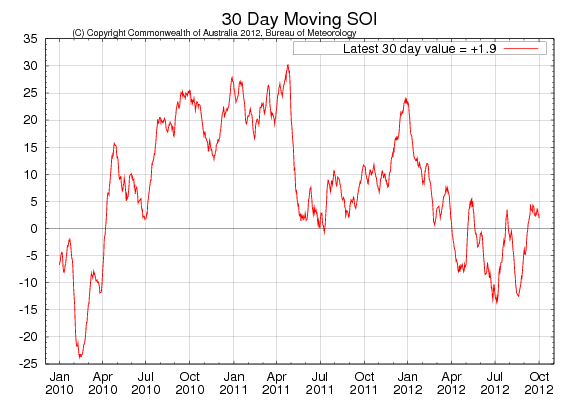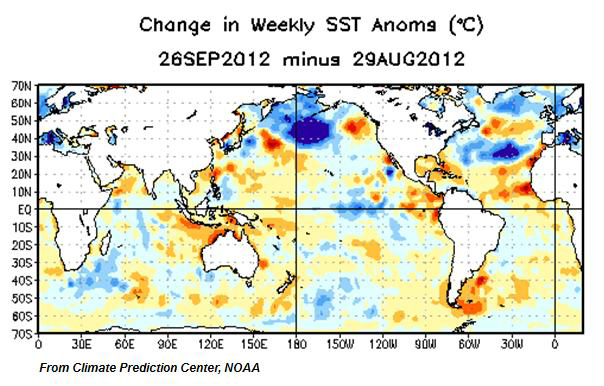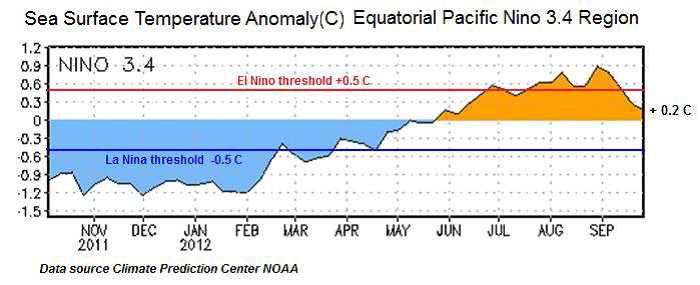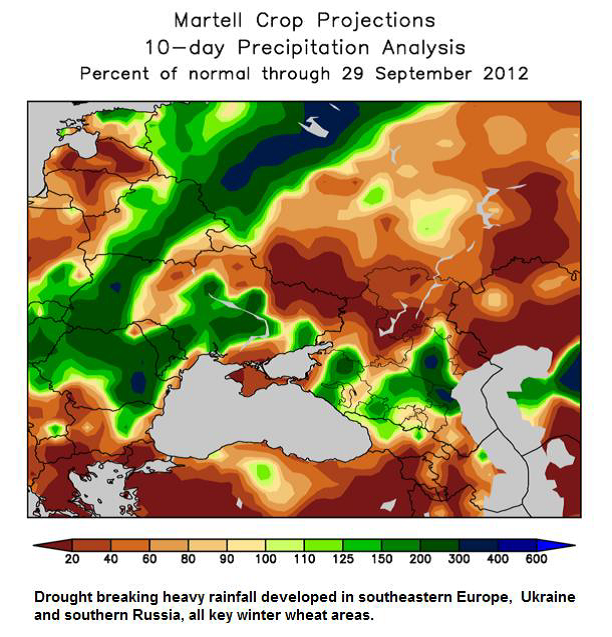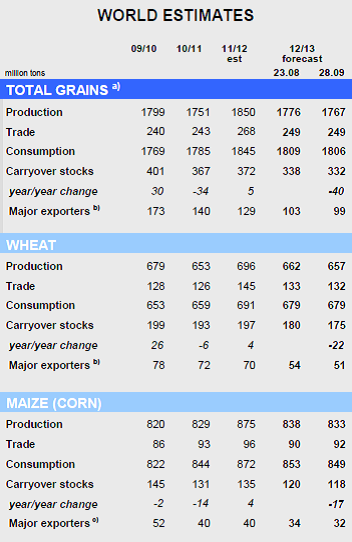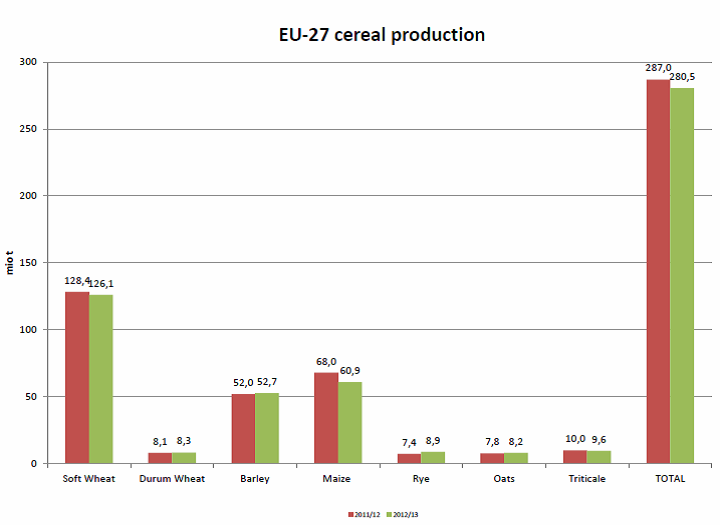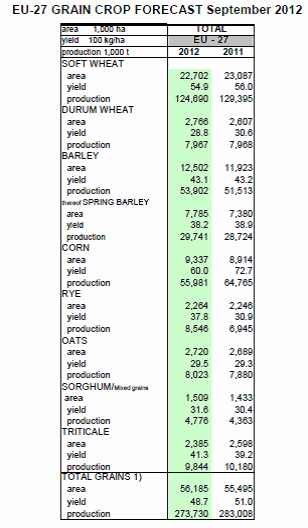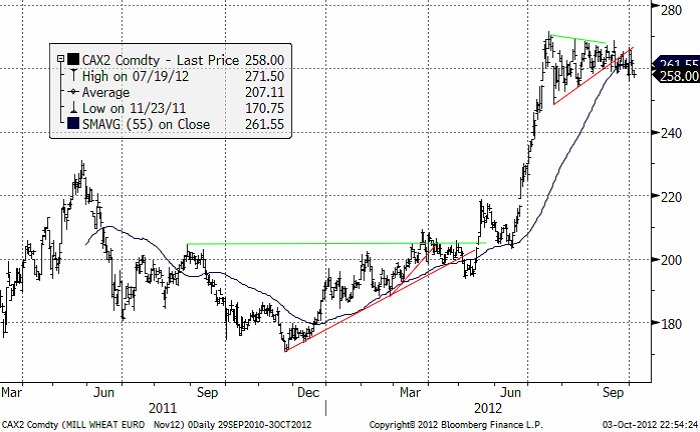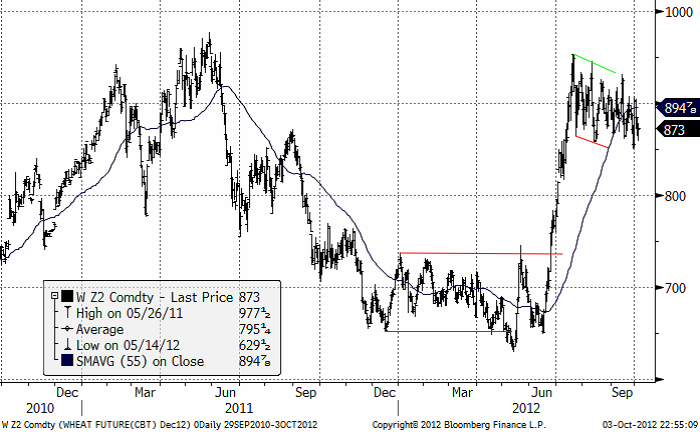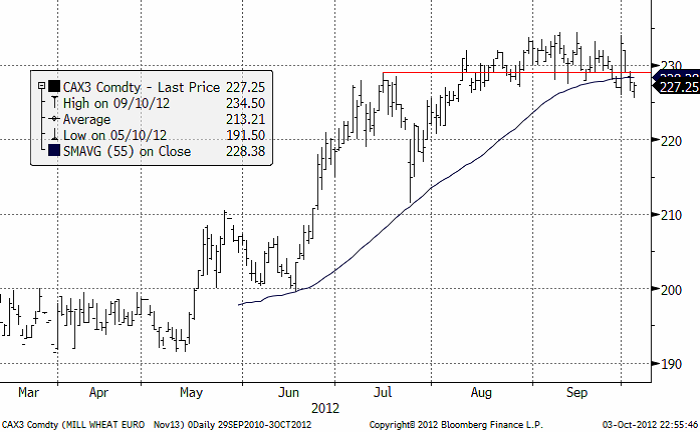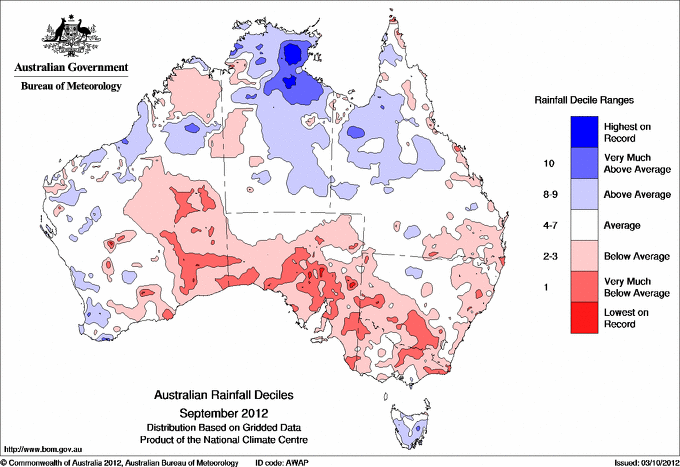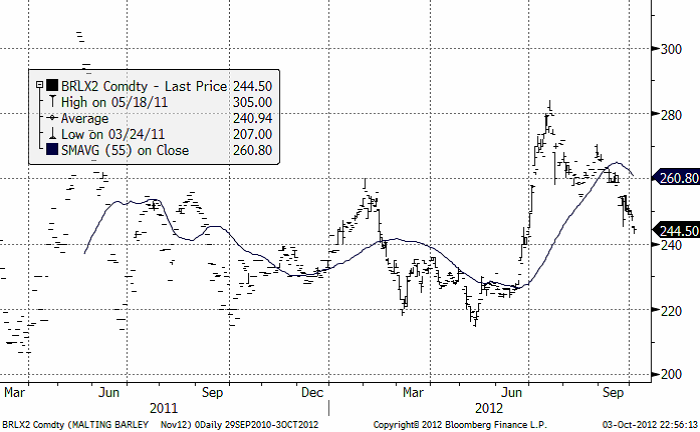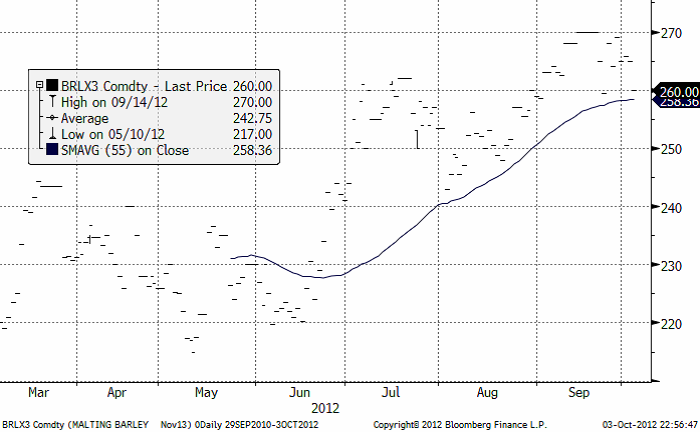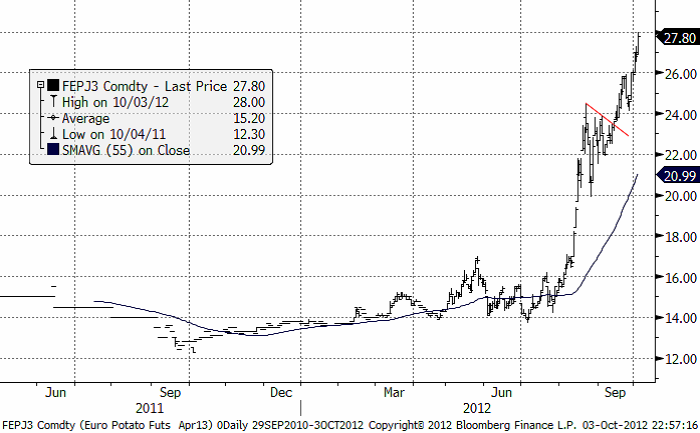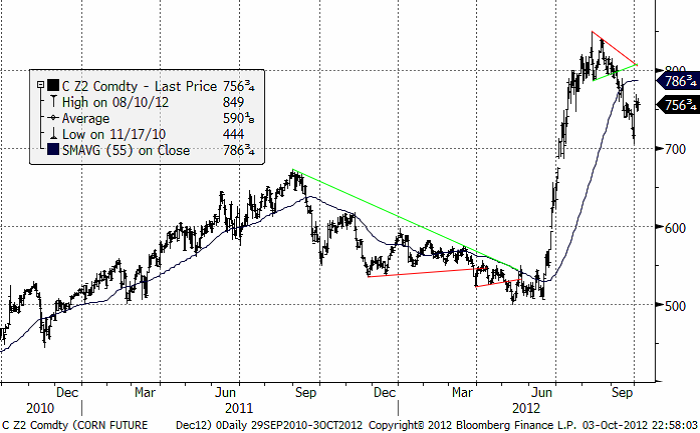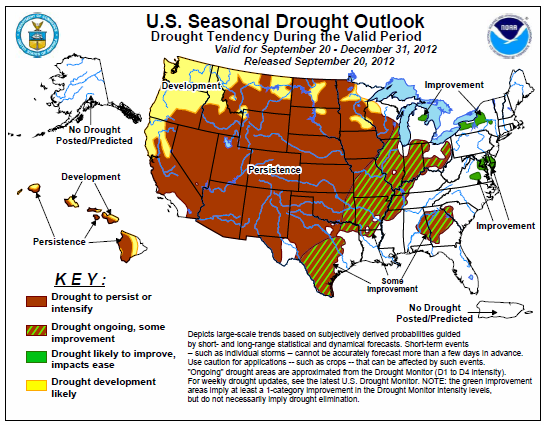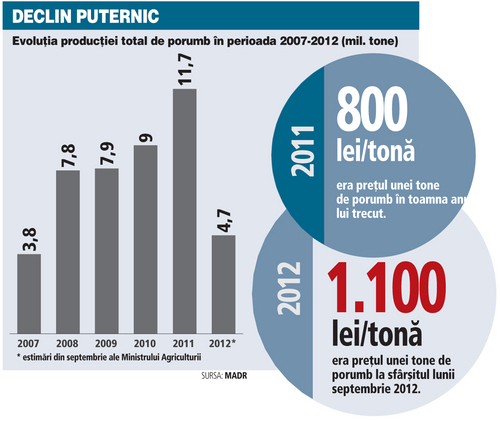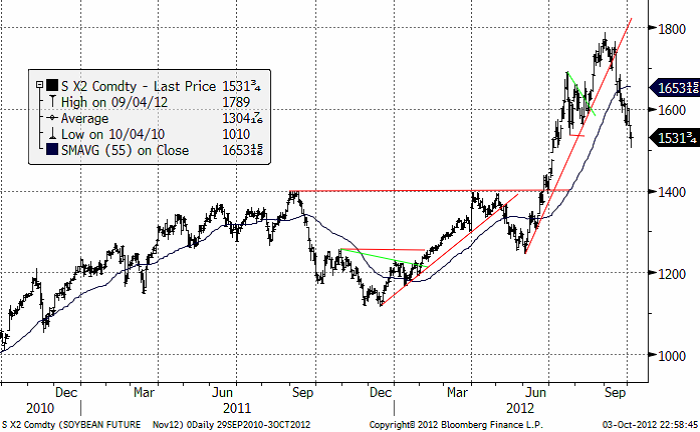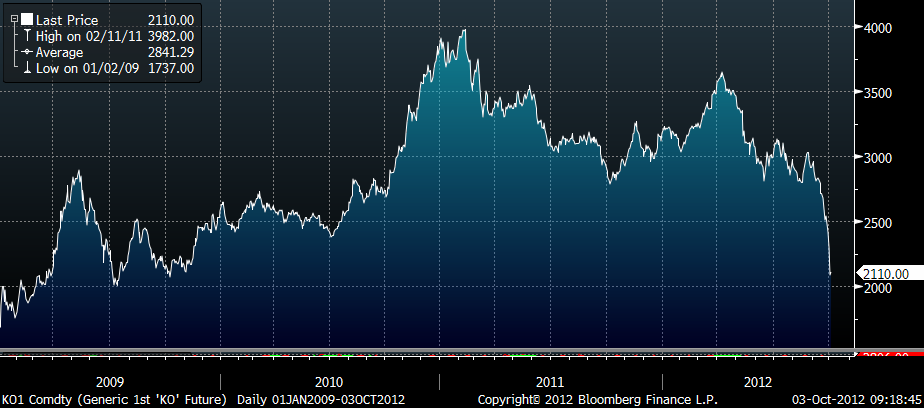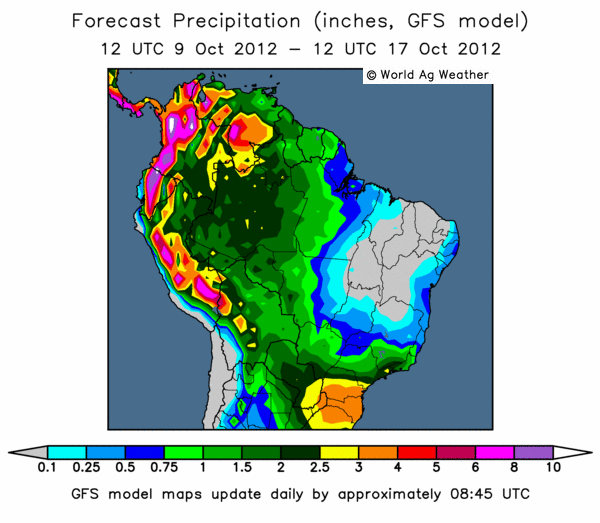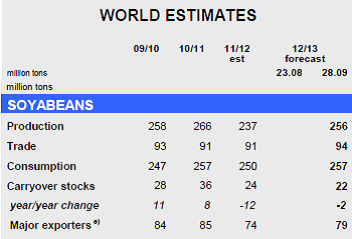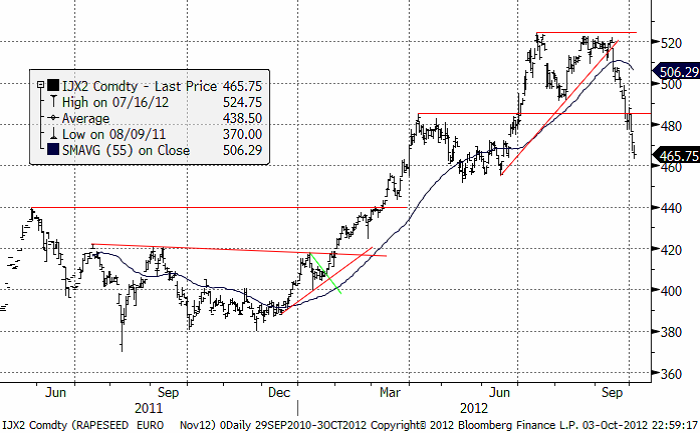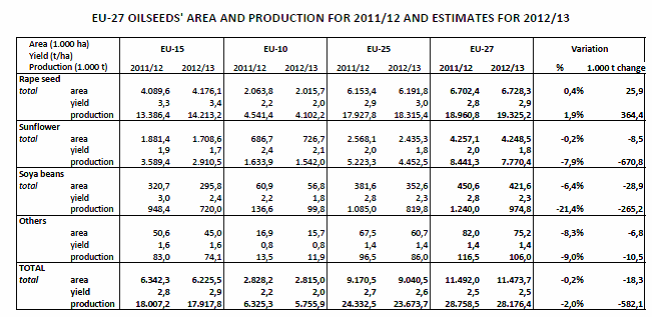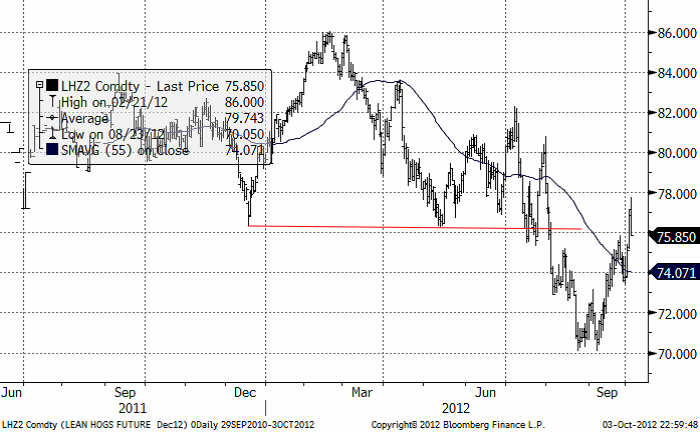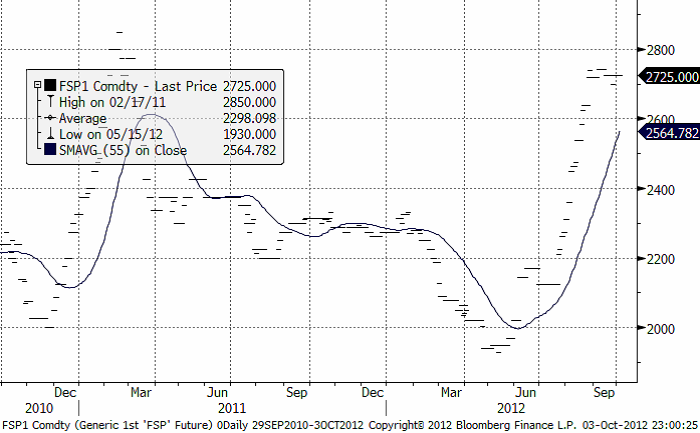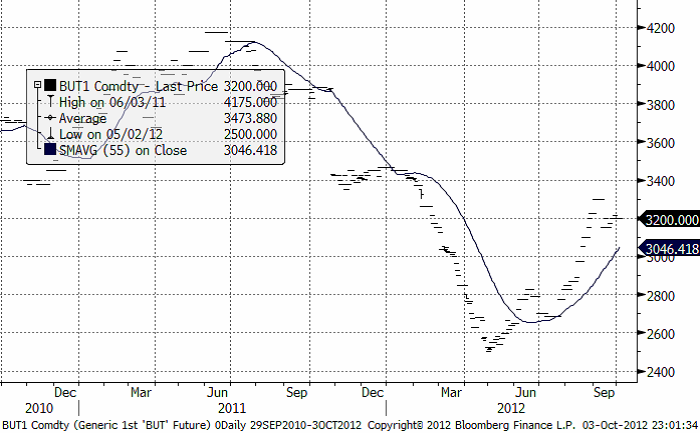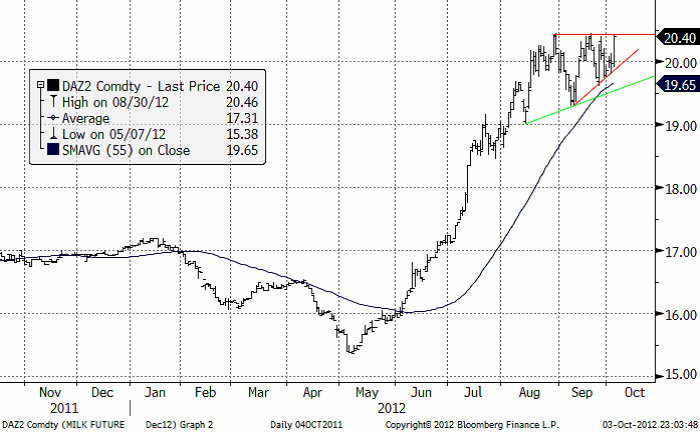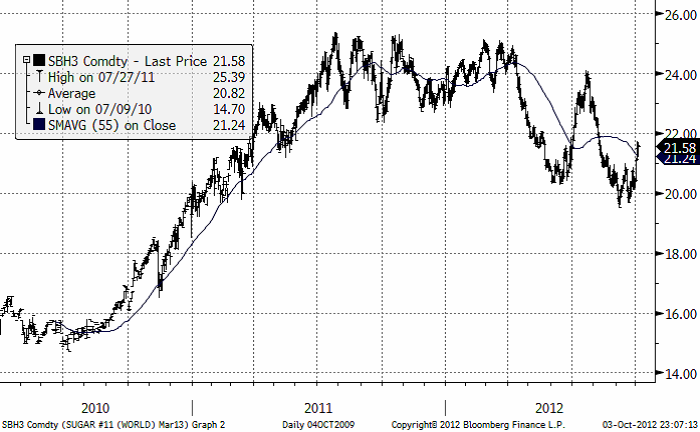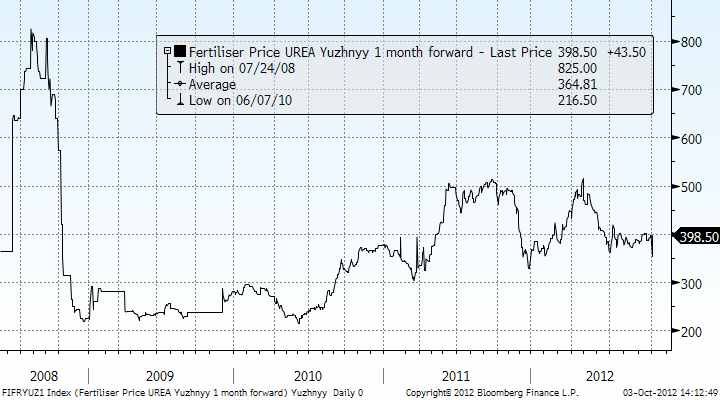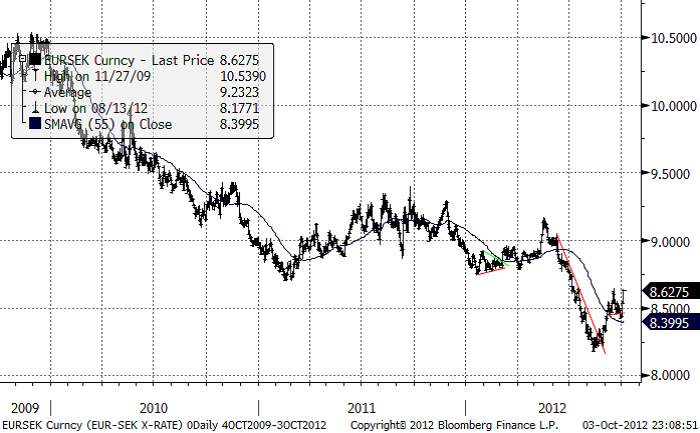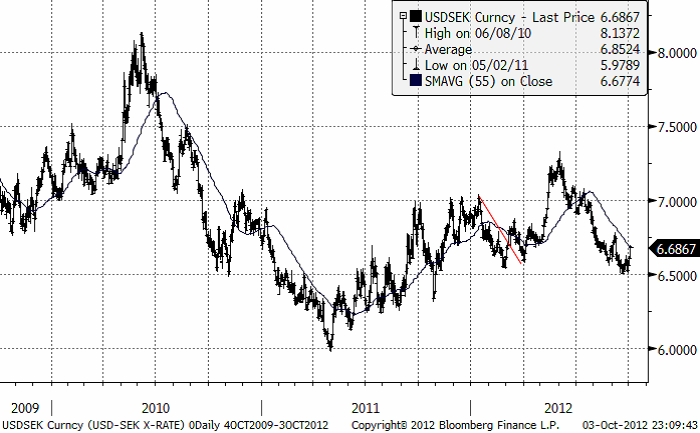Analys
SEB Jordbruksprodukter, 4 oktober 2012
 Veckan har varit relativt lugn efter att aktiviteten i spåren av förra fredagens lagerstatistik från USDA. Idag och imorgon äger den stora spannmålsmässan European Bourse rum i Edinburgh. Även vi har två representanter där. Nästa vecka återkommer vi de med rapport därifrån.
Veckan har varit relativt lugn efter att aktiviteten i spåren av förra fredagens lagerstatistik från USDA. Idag och imorgon äger den stora spannmålsmässan European Bourse rum i Edinburgh. Även vi har två representanter där. Nästa vecka återkommer vi de med rapport därifrån.
El Niño-tendensen har minskat rejält och ENSO är nu neutral med vissa tecken som tyder på La Niña.
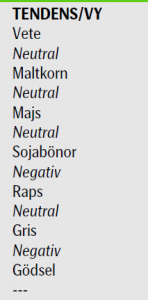 Vi ändrar rekommendationen för majs från negativ till neutral och för sojabönor från neutral till negativ.
Vi ändrar rekommendationen för majs från negativ till neutral och för sojabönor från neutral till negativ.
Nu skriver vi återigen om gödsel och det är något som vi faktiskt handlar på termin nu. Utvecklingen har gått framåt där.
Odlingsväder
El Niño-signalerna har försvagats så mycket den senaste tiden, att väderförhållandena påminner allt mer om La Niña. Nedan ser vi Southern Oscillation Index (”SOI”), som stigit från El Niño-nivåer till neutral nivå.
Temperaturerna har sjunkit i Stilla Havet och gått till för ENSO neutrala värden. Nedan ser vi en bild på förändringen i temperatur mellan 29 augusti och 26 september.
Nedan ser vi hur temperaturförändringen i havet hänger ligger I förhållande till ENSO.
Nedan ser vi ökad nederbörd I Ryssland (grönt, blått), som förbättrar situationen för höstvetet.
Väderleksprognosen visar fortsatt torrt väder på norra Prärien i USA och i den östra Mellanvästern. I Europa håller sig nederbörden fokuserad till Nordeuropa. Södra och Östra Europa missar nederbörden. Australien är totalt torrt. Den rikliga nederbörd som fallit i norra Argentina och södra Brasilien har utvidgat sitt område något.
IGC / Copa-Cogecas / Coceral
IGC justerar ned sitt estimat för den globala spannmålsproduktionen 2012/13 med ytterligare 9 mt denna månad till 1,767 mt, framförallt pga nedrevideringar för ryskt och australiensiskt vete samt vete och majs i EU. Den totala produktionen beräknas nu att sjunka med 4% på årsbasis. Den globala produktionen av vete justeras ned 5 mt till 657 mt, en nedgång med 6% på årsbasis, och den globala konsumtionen beräknas minska med 2% till 679 mt, då höga priser minskar efterfrågan på foder. Den globala produktionen av majs justeras ned med 5% på årsbasis till 833 mt, då bl.a produktionen i EU förväntas sjunka med 4.9 mt. Däremot lämnas produktionen i USA oförändrad från förra månaden på 275 mt. Stora skördar på det södra halvklotet bör bidra till utbudet under andra halvan av 2012/13, men det förutsättergynnsamma väderförhållanden. Efterfrågan kommer dock sannolikt att minska i takt med ett höga priser och ett begränsat utbud, där användningen, både foder och industriell, förväntas sjunka.
Globala lager för spannmål har justerats ned med ytterligare 6 mt för 2012/13, vilket är en nedgång med 40 mt på årsbasis till den lägsta nivån på 5 år. Majs lagren beräknas sjunka med 17 mt på årsbasis till ettsex-års-lägsta. Även korn lagren minska för tredje året i rad. Utgående lager för vete 2012/13 justeras nedfrån 180 mt till 175 mt, där utsikterna för de största exportörerna blir alltmer tighta.
Sådden av höstgrödor på norra halvklotet är i full gång och arealen för vete 2013/14 beräknas preliminärt att öka med 2% som en följd av höga priser och en återhämtning från väder relaterade skador på grödor under 2012/13.
b) Argentina, Australia, Canada, EU, Kazakhstan, Russia, Ukraine, US
c) Argentina, Brazil, Ukraine, US
Källa: IGC
Copa-Cogecas, som företräder EUs lantbrukare och lantbrukskooperativ i Bryssel, kom med sin slutliga uppskattning för EU-27 spannmålsproduktion för 2012/13 och säger där att produktionen förväntas minska med 2,2%, vilket visar på behovet av att bibehålla full produktionskapacitet i framtiden för att möta en växande efterfrågan.
Källa: Coceral
Cocerals senaste prognos visar på en nedjustering av vete 2012 till 124,69 mt mot tidigare estimat på 125.51 mt. Den totala produktionen av vete (inkl durum) uppskattas till 132.66 mt, vilket är i linje med USDA’s prognos. Även prognosen för majs och justeras ned till 55.98 mt (att jämföra med tidigare estimat på 65.73 mt) medan estimatet för korn justeras upp till 53.9 mt från tidigare 52.57 mt.
Källa: Coceral
Vete
Vetemarknaden har fortsatt att röra sig väldigt lite. Tekniskt är den gamla triangeln ett motstånd för prisuppgångar. Det finns uppenbarligen gott om säljare i Matifs novemberkontrakt på nivåer nära 270 euro per ton. Det är osäkert om den här ”sidledes” rörelsen är en konsolidering inför ytterligare en prisuppgång – eller en toppformation. Tekniskt ser det ut att vara högre sannolikhet för att det är en topp-formation.
Nedan ser vi Chicagovetet med leverans i december. 55-dagars glidande medelvärde är brutet och marknaden står och väger.
Nedanför ser vi prisdiagrammet för Matifs november 2013-kontrakt. Priset har de senaste dagarna fallit av och ligger nu under toppformationens stödlinje och under 55-dagars glidande medelvärde. Det ser ut som om trenden håller på att vända ner. Och naturligtvis, för många spannmålsodlare är det attraktivt att låsa in ett pris för nästa år på en förhållandevis hög prisnivå. Varför ta risken, är det säkert många som tänker, när priserna ändå är på mycket höga nivåer.
Måndagens Crop Progress rapport från USDA visar att sådden av amerikanskt höstvete nu är avklarad till 40%, vilket är strax under det femåriga genomsnittet på 43%, och att jämföra med 25% veckan innan.
Egyptens GASC bekräftar idag att man har köpt ytterligare 240 000 to vete för december leverans (11- 20), Vad vi kunde så fanns inga offerter på vete från Ryssland / Svarta Havs-regionen med, utan merparten av vetet var franskt. Fördelningen av köpet ser ut enligt följande:
(60 000 ton franskt vete från Venus för 342.50 usd/ton – 60 000 ton franskt vete från Granit för 345.30 usd/ton – 60 000 ton franskt vete från Nidera för 345.30 usd/ton – 60 000 ton argentinskt vete från Glencore för 333.68 usd/ton)
Utsikterna för Australiens vete har inte direkt förbättrats då nederbörden i september låg under genomsnittet i merparten av fastlandets södra delar och framförallt i New South Wales och Victoria.
Sådden av höstgrödor i Ukraina går framåt och 5.1 miljoner hektar var avklarad per i måndags enligt landets jordbruksminister, vilket är att jämföra med förra årets 4.7 miljoner hektar vid denna tid. Höstvete står för 4.6 miljoner hektar (jämfört med 4.3 året innan). Den totala sådden av vintergrödor förväntas uppgå till 8.2 millioner hektar, samma siffra som förra året.
Rysslands biträdande jordbruksminister säger att landet överväger att sälja 500 000 ton spannmål från statliga interventionslager till Sibirien, Ural och Fjärran Östern regionerna i landet, för att dämpa de stigande inhemska priserna. Även president Putin uttryckte sin oro och sade att inflationen – nu över 6 procent – delvis hade stigit som ett resultat av det ökade trycket på livsmedelspriser som en följd av årets dåliga skörd i Ryssland och utomlands. Per den 28 september uppgick den ryska spannmålsskörden till 66.4 mt, vilket är en minskning med 23% från 86.5 mt vid den här tiden förra året.
Vi avslutar med att visa priserna från Egyptens senaste tender för vete:
– 60,000 Soft Red Winter at $349 from Venus International
– 60,000 French wheat at $342.50 from Venus International
– 60,000 French wheat at $345.94 from Nidera International
– 55,000 Argentine wheat at $334.98 from Nidera International
– 60,000 French wheat at $348.65 a ton from Noble
– 60,000 Soft Red winter at $354.70 a ton from Cenex Harvest
– 60,000 French at $346.88 a ton from Cargill Inc.
– 60,000 Soft Red Winter at $346.91 a ton from Cargill Inc.
– 60,000 French wheat at $350.85 a ton from Bunge Ltd.
– 60,000 French wheat at $349.94 a ton from Soufflet
– 60,000 French at $347.74 a ton from Louis Dreyfus
– Two cargoes of 55,000 Hard Red Winter at $378.50 from Louis Dreyfus
– 60,000 Canadian Soft Red Winter at $349.97 from Louis Dreyfus
– 60,000 French wheat at $350.70 from Toepfer International
– 60,000 French wheat at $346.89 and $351 from In-Vivo
– 60,000 Argentine wheat at $334.68 from Glencore International
– 60,000 French wheat at $349.91 from Glencore International
– 60,000 French wheat at $345.80 from Granit
Maltkorn
Novemberkontraktet på maltkorn har fortsatt att falla. Priset har nu nästan hunnit ner mot 240 euro, där vi ser att det tidigare funnits köpare. Priset på maltkorn kan fortsatta falla lite till, men det borde finnas köpare som stoppar fallet vid eller strax under 240 euro per ton.
Nedan ser vi priset för maltkornterminen med leverans i november 2013. Vi skrev om det märkliga – att dessa priser ligger högre än 2012 års, när vetepriset ligger lägre för 2013 än för 2012. 260 euro per ton för maltkorn måste väl rimligen vara ett bra pris att låsa in?
Potatis
Som vi skrev förra veckan, brukar ett brott uppåt ur en konsolideringsfas som den vi såg mellan 20 och 24 euro leda till ytterligare uppgång. En tumregel är att prisuppgången bli lika lång som uppgången mellan 16 och 22 (mitt i konsolideringsområdet). Potatispriset har nu alltså nästan nått till sitt tekniska prisobjektiv, 28 euro. Den som legat köpt terminer på potatis bör alltså fundera på att ta hem vinsterna – och den som legat köpt den här sortens potatis bör kanske överväga att sälja den.
Majs
Marknaden tvärvände efter fredagens lagerstatistik från USDA. Som vi skrivit tidigare var den senaste WASDE-rapporten ganska ”skum” när det gällde lager i majs. Och det visade sig i lagerstatistiken att den var det. Köparna triumferade. Att marknaden tvärvände från negativ till positiv på så kort tid får vi ta som ett observandum. Möjligen finns nu ännu mer prisuppgång att vänta. För närvarande får vi lov att gå över till neutral rekommendation från negativ.
Måndagens Crop Progress rapport från USDA visar att skörden av amerikansk majs är avklarad till 54% per den 30 september, vilket är en ökning från 39% veckan innan och väl över det femåriga genomsnittet på 20%. Vid samma tid förra året låg siffran på 18%. Både majs och sojabönor har utvecklats tidigare än någonsin i år efter en snabb vårsådd och höga temperaturer under sommaren. Dessutom är bägge skördarna mindre än väntade på grund av den kraftiga torkan som drabbade centrala produktionsområden, vilket också gör att skörden av grödorna går fort framåt. Det torra vädret som nu främjar en snabb skörd kan dock bli till ett stort bekymmer för nästa års majsgrödor om det håller i sig.
Celeres justeras ned sitt estimat för Brasiliens majs produktion 2012/13 till 76.05 mt, en minskning med 400 000 ton från prognosen i september och som en följd av minskad areal då lantbrukare föredrar att så sojabönor istället som ger en högre intjäning.
Efter rapporter om nedjusteringar av Europas majsskördar så höjer flera olika analysfirmor sina prognoser för EU’s import av majs 2012/13. IGC höjde sitt estimat till 8.0 mt, medan Strategie Grains, som efter en nedjustering med 19% av produktionen, reviderar upp importen till 8.2 mt. Den Europeiska unionen uppskattat importen till 6.5 mt medan USDA i senaste WASDE rapporten har en siffra på 3 mt. Frågan är också om dessa prognoser är i underkant med dåliga skördar i delar av unionen, framförallt i Ungern och Rumänien – se nedan.
Majsproduktionen i Rumänien förväntas uppgå till 4.7 mt, en minskning med 60% jämfört med 11.7 mt under rekordåret 2011, enligt de första officiella uppskattningarna gjorda av landets jordbruksministerium (MADR) och bygger på att lantbrukare tidigare har aviserat stora förluster av grödan till följd av torka och höga temperaturer. Emellertid, så indikerar andra källor en lägre minskning mellan 35% och 50%. Den Europeiska Kommissionen uppskattar produktionen till 7 mt, en minskning med 30% och Coceral estimerar skörden till 5.2 mt, ner 55%.
Priset på ett ton majs under hösten förra året var 800 lei/ton (ca 1500 kr/ton). Priset på ett ton majs i slutet på september 2012 var 1,100 lei/ton (ca 2,250 kr/ton).
Frankrike är på väg att exportera majs till Sydkorea för första gången, och det verkar också bli den hittills största transporten (55 000 ton) av majs någonsin, enligt statistik från hamnen La Pallice. Frankrike är den största producenten av majs i EU, men överskottet efter inhemskt bruk exporteras vanligtvis till andra länder inom EU.
Sojabönor
Novemberkontraktet har brutit alla stöd innan 1400 cent. Vi är negativa till prisutvecklingen framöver.
Sojabönor fortsätter att falla för tredje dagen i rad och noterar nu ett 3-månaders lägsta, på nya rapporter om högre produktion i USA och rapporter om regn i södra Brasilien och Argentina.
Palmolja i Malaysia noterade det största dagliga prisfallet sedan oktober 2008 och föll till den lägsta nivån sedan 2009 som en följd av lägre efterfrågan, höga lager och det pågående kinesiska helgfirandet av nationaldagen (30 sept – 7 okt).
Måndagens Crop Progress rapport från USDA visar att skörden av amerikanska sojabönor är avklarad till 41% jämfört med 22% veckan innan. Det femåriga genomsnittet i slutet på september ligger på 19%.
Inga större förändringar har gjorts i ratingen och sojabönor klassade som ”good/excellent” var oförändrade från veckan innan, medan sojabönor klassade som ”poor” sjönk från 20% till 19%. Väderprognoserna visar på fortsatt torrt väder i Mellanvästern kommande dagar och skapar förutsättningar för ytterligare en aktiv vecka på fälten.
Regnet som föll sporadiskt över Brasilien under september väntas öka och sprida sig över de viktigaste produktionsområdena fr.o.m mitten av oktober, vilket banar väg för sådden av det som förväntas bli en rekordskörd. Kallfronter från Argentina i söder som blandar sig med fukten från Amazonas väntas ge omfattande regn över Mato Grosso do Sul och Goias.
Celeres säger dessutom att skörden 2012/13 förväntas bli ännu större än vad som estimerades i september och justerar upp sin prognos till 79.08 mt, en ökning med nästan 1 mt från estimatet på 78.1 mt i början på september. Anledningen till den reviderade prognosen är bl.a en ökning av arealen för sojabönor, delvis på bekostnad av majs, och där den största ökningen förväntas i Mato Grosso (+11%).
IGC skriver i sin senaste rapport att priset på sojabönor har sjunkit på månadsbasis som en följd av den pågående skörden och indikationer på en högre avkastning är förväntat. De justerar upp sin prognos för den globala produktionen av sojabönor 2012/13 med 8% till 256 mt, som en följd av en förväntad rekordskörd i Sydamerika där bl.a Brasilien kan komma att uppgå till 75-80 mt om vädret samarbetar.
Raps
Vi skrev förra veckan om den tekniska säljsignalen som utlöstes när priset gick under bottennoteringen från början på augusti. Nu är dock priset nere på den nivå där marknaden uppehöll sig länge under maj och juni, vid 460 euro. Vi tror på ”sidledes” rörelse nu och att prisfallet alltså tar en paus.
Priset på raps noterar nu den lägsta nivån sedan juni.
Copa-Cogeca’s senaste estimat för EU-27 visar på en ökning av rapsproduktionen 2012/13 med 364 400 ton jämfört med 2011/12. Den totala produktionen av oljeväxter i EU-27 förväntas dock minska med 2%.
Statistics Canada kommer med sin rapport under eftermiddagen idag och enligt en undersökning bland handlare och analytiker förväntas skörden av canola att uppgå till ca 14.6 mt, vilket är en minskning från StatCan’s tidigare estimat i slutet på augusti men fortfarande en rekordnivå.
Coceral har justerat upp sin prognos för EU’s produktion av oljeväxter med 970 000 ton till 28.1 mt. Revideringen beror framförallt på förbättrade utsikter för raps, som estimeras till 20.5 mt vilket överstiger förra årets skörd som drabbades av väderrelaterade problem.
Gris
Grispriset har förmodligen nått så långt upp som den orkar. Den långsiktiga trenden är nedåtriktad och den kortsiktiga rekylen uppåt är antagligen slut eller nära slutet.
Mjölk
Priset på mjölkpulver i Nordeuropa noteras 25 euro per ton högre än förra veckans 2700 euro.
Nedan ser vi priset på smör, ligger kvar på samma pris som förra veckan.
På den amerikanska börsen CME i Chicago testar priset på Klass 3 mjölk nu högstanoteringen. Ett brott uppåt öppnar för ytterligare uppgång, men den relativt kraftiga rekylen i september ger en varningssignal om att uppåttrenden är ifrågasatt av somliga på marknaden.
Socker
Nedan ser vi priset för leverans i mars nästa år. Trots ett starkt stöd vid 20 cent, ser vi tydligt att den långsiktiga trenden är nedåtriktad.
Gödsel
Veckan startade relativt starkt med Yuzhnyy mid-nivåer från 400 $/mt för oktober 12 upp mot 410 $/mt för Q1-13, Samma starka start gällde även för Egypt. Sedan dess har marknaden försvagats med lägre bid-nivåer och ni noterar att Yuzhnyy midpriser för 2012 nu ligger under 400 $/mt strecket. Egyptennoteringen å andra sidan har hållit sig stabil runt 460 $/mt. Urea NOLA håller sig relativt oförändrad och handlas i contango från 430 $/st för oktober upp till 455 $/st för Q1-13.
EURSEK
EURSEK-trenden pekar uppåt. Det talas i pressen om att kronan är den mest övervärderade valutan av alla OECD-valutor. Att Sverige skulle klara sig jättebra, när resten av Europa har problem, och flera länder i södra Europa egentligen varit i konkurs i två år, är inte sannolikt.
USDSEK
Dollarn som fallit mot kronan ser ut att ha funnit en botten. Kursen testar nu ett trendbrott uppåt. Ytterligare kursuppgång de närmaste dagarna bekräftar att ett trendbrott skett och då bör man vara köpt dollar.
[box]SEB Veckobrev Jordbruksprodukter är producerat av SEB Merchant Banking och publiceras i samarbete och med tillstånd på Råvarumarknaden.se[/box]
Disclaimer
The information in this document has been compiled by SEB Merchant Banking, a division within Skandinaviska Enskilda Banken AB (publ) (“SEB”).
Opinions contained in this report represent the bank’s present opinion only and are subject to change without notice. All information contained in this report has been compiled in good faith from sources believed to be reliable. However, no representation or warranty, expressed or implied, is made with respect to the completeness or accuracy of its contents and the information is not to be relied upon as authoritative. Anyone considering taking actions based upon the content of this document is urged to base his or her investment decisions upon such investigations as he or she deems necessary. This document is being provided as information only, and no specific actions are being solicited as a result of it; to the extent permitted by law, no liability whatsoever is accepted for any direct or consequential loss arising from use of this document or its contents.
About SEB
SEB is a public company incorporated in Stockholm, Sweden, with limited liability. It is a participant at major Nordic and other European Regulated Markets and Multilateral Trading Facilities (as well as some non-European equivalent markets) for trading in financial instruments, such as markets operated by NASDAQ OMX, NYSE Euronext, London Stock Exchange, Deutsche Börse, Swiss Exchanges, Turquoise and Chi-X. SEB is authorized and regulated by Finansinspektionen in Sweden; it is authorized and subject to limited regulation by the Financial Services Authority for the conduct of designated investment business in the UK, and is subject to the provisions of relevant regulators in all other jurisdictions where SEB conducts operations. SEB Merchant Banking. All rights reserved.
Analys
Tightening fundamentals – bullish inventories from DOE

The latest weekly report from the US DOE showed a substantial drawdown across key petroleum categories, adding more upside potential to the fundamental picture.

Commercial crude inventories (excl. SPR) fell by 5.8 million barrels, bringing total inventories down to 415.1 million barrels. Now sitting 11% below the five-year seasonal norm and placed in the lowest 2015-2022 range (see picture below).
Product inventories also tightened further last week. Gasoline inventories declined by 2.1 million barrels, with reductions seen in both finished gasoline and blending components. Current gasoline levels are about 3% below the five-year average for this time of year.
Among products, the most notable move came in diesel, where inventories dropped by almost 4.1 million barrels, deepening the deficit to around 20% below seasonal norms – continuing to underscore the persistent supply tightness in diesel markets.
The only area of inventory growth was in propane/propylene, which posted a significant 5.1-million-barrel build and now stands 9% above the five-year average.
Total commercial petroleum inventories (crude plus refined products) declined by 4.2 million barrels on the week, reinforcing the overall tightening of US crude and products.


Analys
Bombs to ”ceasefire” in hours – Brent below $70

A classic case of “buy the rumor, sell the news” played out in oil markets, as Brent crude has dropped sharply – down nearly USD 10 per barrel since yesterday evening – following Iran’s retaliatory strike on a U.S. air base in Qatar. The immediate reaction was: “That was it?” The strike followed a carefully calibrated, non-escalatory playbook, avoiding direct threats to energy infrastructure or disruption of shipping through the Strait of Hormuz – thus calming worst-case fears.

After Monday morning’s sharp spike to USD 81.4 per barrel, triggered by the U.S. bombing of Iranian nuclear facilities, oil prices drifted sideways in anticipation of a potential Iranian response. That response came with advance warning and caused limited physical damage. Early this morning, both the U.S. President and Iranian state media announced a ceasefire, effectively placing a lid on the immediate conflict risk – at least for now.
As a result, Brent crude has now fallen by a total of USD 12 from Monday’s peak, currently trading around USD 69 per barrel.
Looking beyond geopolitics, the market will now shift its focus to the upcoming OPEC+ meeting in early July. Saudi Arabia’s decision to increase output earlier this year – despite falling prices – has drawn renewed attention considering recent developments. Some suggest this was a response to U.S. pressure to offset potential Iranian supply losses.
However, consensus is that the move was driven more by internal OPEC+ dynamics. After years of curbing production to support prices, Riyadh had grown frustrated with quota-busting by several members (notably Kazakhstan). With Saudi Arabia cutting up to 2 million barrels per day – roughly 2% of global supply – returns were diminishing, and the risk of losing market share was rising. The production increase is widely seen as an effort to reassert leadership and restore discipline within the group.
That said, the FT recently stated that, the Saudis remain wary of past missteps. In 2018, Riyadh ramped up output at Trump’s request ahead of Iran sanctions, only to see prices collapse when the U.S. granted broad waivers – triggering oversupply. Officials have reportedly made it clear they don’t intend to repeat that mistake.
The recent visit by President Trump to Saudi Arabia, which included agreements on AI, defense, and nuclear cooperation, suggests a broader strategic alignment. This has fueled speculation about a quiet “pump-for-politics” deal behind recent production moves.
Looking ahead, oil prices have now retraced the entire rally sparked by the June 13 Israel–Iran escalation. This retreat provides more political and policy space for both the U.S. and Saudi Arabia. Specifically, it makes it easier for Riyadh to scale back its three recent production hikes of 411,000 barrels each, potentially returning to more moderate increases of 137,000 barrels for August and September.
In short: with no major loss of Iranian supply to the market, OPEC+ – led by Saudi Arabia – no longer needs to compensate for a disruption that hasn’t materialized, especially not to please the U.S. at the cost of its own market strategy. As the Saudis themselves have signaled, they are unlikely to repeat previous mistakes.
Conclusion: With Brent now in the high USD 60s, buying oil looks fundamentally justified. The geopolitical premium has deflated, but tensions between Israel and Iran remain unresolved – and the risk of missteps and renewed escalation still lingers. In fact, even this morning, reports have emerged of renewed missile fire despite the declared “truce.” The path forward may be calmer – but it is far from stable.
Analys
A muted price reaction. Market looks relaxed, but it is still on edge waiting for what Iran will do

Brent crossed the 80-line this morning but quickly fell back assigning limited probability for Iran choosing to close the Strait of Hormuz. Brent traded in a range of USD 70.56 – 79.04/b last week as the market fluctuated between ”Iran wants a deal” and ”US is about to attack Iran”. At the end of the week though, Donald Trump managed to convince markets (and probably also Iran) that he would make a decision within two weeks. I.e. no imminent attack. Previously when when he has talked about ”making a decision within two weeks” he has often ended up doing nothing in the end. The oil market relaxed as a result and the week ended at USD 77.01/b which is just USD 6/b above the year to date average of USD 71/b.

Brent jumped to USD 81.4/b this morning, the highest since mid-January, but then quickly fell back to a current price of USD 78.2/b which is only up 1.5% versus the close on Friday. As such the market is pricing a fairly low probability that Iran will actually close the Strait of Hormuz. Probably because it will hurt Iranian oil exports as well as the global oil market.
It was however all smoke and mirrors. Deception. The US attacked Iran on Saturday. The attack involved 125 warplanes, submarines and surface warships and 14 bunker buster bombs were dropped on Iranian nuclear sites including Fordow, Natanz and Isfahan. In response the Iranian Parliament voted in support of closing the Strait of Hormuz where some 17 mb of crude and products is transported to the global market every day plus significant volumes of LNG. This is however merely an advise to the Supreme leader Ayatollah Ali Khamenei and the Supreme National Security Council which sits with the final and actual decision.
No supply of oil is lost yet. It is about the risk of Iran closing the Strait of Hormuz or not. So far not a single drop of oil supply has been lost to the global market. The price at the moment is all about the assessed risk of loss of supply. Will Iran choose to choke of the Strait of Hormuz or not? That is the big question. It would be painful for US consumers, for Donald Trump’s voter base, for the global economy but also for Iran and its population which relies on oil exports and income from selling oil out of that Strait as well. As such it is not a no-brainer choice for Iran to close the Strait for oil exports. And looking at the il price this morning it is clear that the oil market doesn’t assign a very high probability of it happening. It is however probably well within the capability of Iran to close the Strait off with rockets, mines, air-drones and possibly sea-drones. Just look at how Ukraine has been able to control and damage the Russian Black Sea fleet.
What to do about the highly enriched uranium which has gone missing? While the US and Israel can celebrate their destruction of Iranian nuclear facilities they are also scratching their heads over what to do with the lost Iranian nuclear material. Iran had 408 kg of highly enriched uranium (IAEA). Almost weapons grade. Enough for some 10 nuclear warheads. It seems to have been transported out of Fordow before the attack this weekend.
The market is still on edge. USD 80-something/b seems sensible while we wait. The oil market reaction to this weekend’s events is very muted so far. The market is still on edge awaiting what Iran will do. Because Iran will do something. But what and when? An oil price of 80-something seems like a sensible level until something do happen.
-

 Nyheter4 veckor sedan
Nyheter4 veckor sedanUppgången i oljepriset planade ut under helgen
-

 Nyheter3 veckor sedan
Nyheter3 veckor sedanMahvie Minerals växlar spår – satsar fullt ut på guld
-

 Nyheter4 veckor sedan
Nyheter4 veckor sedanLåga elpriser i sommar – men mellersta Sverige får en ökning
-

 Nyheter2 veckor sedan
Nyheter2 veckor sedanOljan, guldet och marknadens oroande tystnad
-

 Nyheter2 veckor sedan
Nyheter2 veckor sedanJonas Lindvall är tillbaka med ett nytt oljebolag, Perthro, som ska börsnoteras
-

 Analys4 veckor sedan
Analys4 veckor sedanVery relaxed at USD 75/b. Risk barometer will likely fluctuate to higher levels with Brent into the 80ies or higher coming 2-3 weeks
-

 Analys3 veckor sedan
Analys3 veckor sedanA muted price reaction. Market looks relaxed, but it is still on edge waiting for what Iran will do
-

 Nyheter2 veckor sedan
Nyheter2 veckor sedanDomstolen ger klartecken till Lappland Guldprospektering


